
Pallenis is a small genus of flowering plants in the tribe Inuleae within the family Asteraceae. The name is derived from palea (chaff), referring to the chaffy receptacle.

Viscount Alexandre Henri Gabriel (vicomte) de Cassini was a French botanist and naturalist, who specialised in the sunflower family (Asteraceae).

Guizotia is a genus of African herbs in the family Asteraceae. They are often known as sunflecks. The species Guizotia abyssinica is occasionally found outside of cultivation in Europe, North America and Asia.

Leucophyta is a plant genus which is endemic to Australia. The genus was first formally described by botanist Robert Brown in 1818.

Celmisia is a genus of perennial herbs or subshrubs, in the family Asteraceae. Most of the species are endemic to New Zealand; several others are endemic to Australia.

Egletes is a genus of flowering plants in the family Asteraceae. It is native to South America, Mesoamerica, and the West Indies, with the range of one species barely crossing the US border into the extreme southern part of Texas.
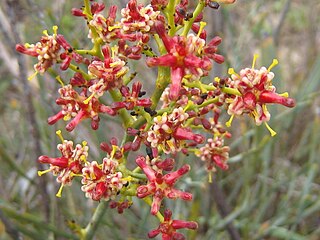
Stirlingia, commonly known as blueboy, is a genus of 7 species in the family Proteaceae, all of which are endemic to Western Australia.
Banksia tenuis var. reptans is a variety of Banksia tenuis. It was known as Dryandra tenuifolia var. reptans until 2007, when Austin Mast and Kevin Thiele sunk all Dryandra into Banksia. Since the name Banksia tenuifolia had already been used, Mast and Thiele had to choose a new specific epithet for D. tenuifolia and hence for this variety of it. As with other members of Banksia ser. Dryandra, it is endemic to the South West Botanical Province of Western Australia.
Banksia tenuis var. tenuis is a variety of Banksia tenuis. It was known as Dryandra tenuifolia var. tenuifolia until 2007, when Austin Mast and Kevin Thiele sunk all Dryandra into Banksia. Since the name Banksia tenuifolia had already been used, Mast and Thiele had to choose a new specific epithet for D. tenuifolia and hence for this variety of it. As with other members of Banksia ser. Dryandra, it is endemic to the South West Botanical Province of Western Australia. As an autonym, it is defined as encompassing the type material of the species.
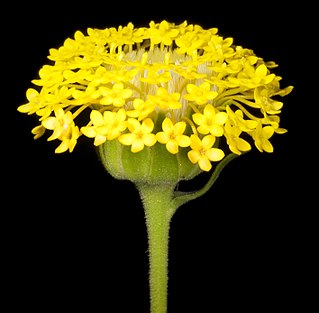
Podotheca is a genus of flowering plants in the tribe Gnaphalieae within the family Asteraceae. All species are endemic to Western Australia, except for Podotheca angustifolia which occurs across the south of Australia.
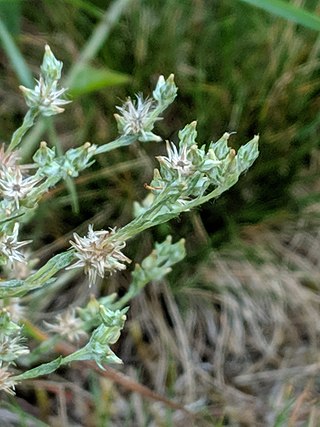
Logfia is a genus of herbaceous plants in the tribe Gnaphalieae of the family Asteraceae, known as cottonrose.
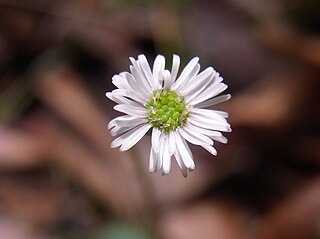
Lagenophora is a genus of flowering plants in the family Asteraceae. Species occur in South-east Asia, Australia, New Zealand, as well as Central and South America.
Nolletia is a genus of flowering plants in the tribe Astereae within the family Asteraceae. The genus was named in honour of Jean-Antoine Nollet, French clergyman and physicist.
Millotia is a genus of small annual herbs in the tribe Gnaphalieae within the family Asteraceae.
Riencourtia is a genus of South American plants in the tribe Heliantheae within the family Asteraceae.
Pegolettia is a genus of African plants in the tribe Inuleae within the family Asteraceae.

Blainvillea is a genus of flowering plants in the family Asteraceae. They are native to tropical and subtropical regions of Africa, Australia, and Latin America.
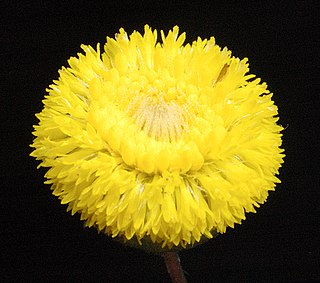
Panaetia, a genus in the Asteraceae (daisy) family, was first described by Henri Cassini in 1829 It is considered by Plants of the World Online and the Global Compositae Database to be a synonym of Podolepis Labil,. while GBIF states it as "doubtful". However, in 2021, the Western Australian Herbarium accepted Jeffery Jeanes new circumscription of the genus, together with two species of Panaetia as being found in Western Australia: Panaetia lessonii, and Panaetia tepperi. Jeanes distinguished Panaetia from the genera, Podolepis, Siemssenia and Walshia, using the following characters:
- the outer florets are all tubular; and
- the cypselas are minutely tuberculate and lack long finger-like papillae.

Podolepis lessonii is an erect annual herb native to Western Australia, belonging to the Asteraceae family.

Schoenia cassiniana is a species of plant in the tribe Gnaphalieae within the family Asteraceae, native to Western Australia, South Australia and the Northern Territory. It was first described in 1829 by Charles Gaudichaud-Beaupré as Helichrysum cassinianum, but was transferred to the genus Schoenia in 1845 by Joachim Steetz.
















